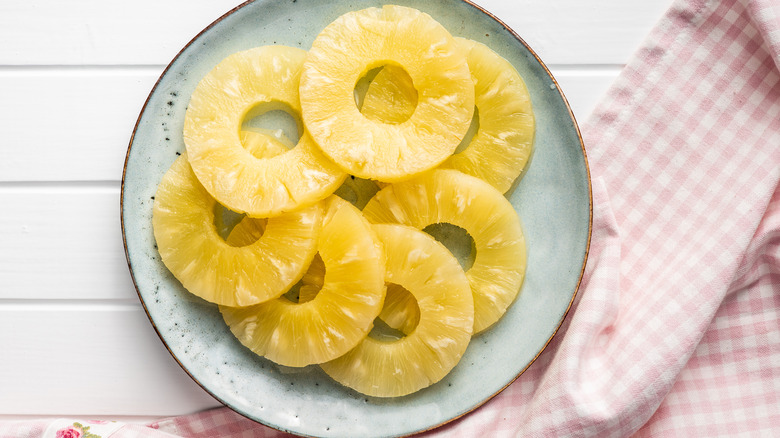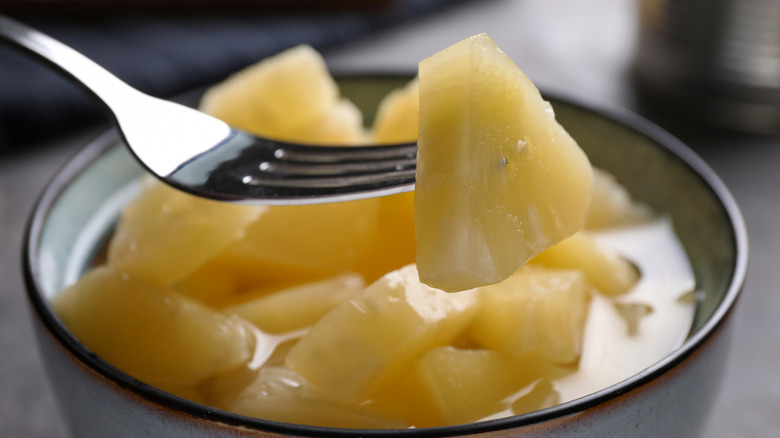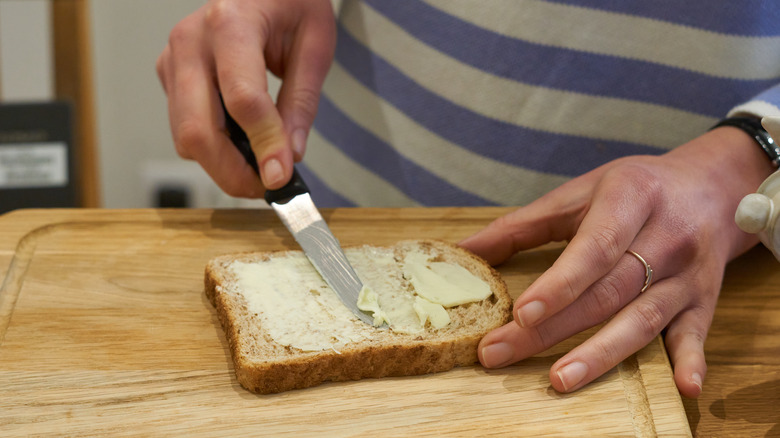Pineapple Sandwiches Are A Southern Classic Mayo Lovers Will Adore
If you want a snack that's both fulfilling and sweet, you can't go wrong with a pineapple sandwich. Although pineapples may conjure visions of the Caribbean and a tropical environment, the pineapple sandwich actually originates in the Southern part of the United States. It's a favorite for many who've tried it, somehow bold but simple in execution. It stands alongside other Southern classics, including the tomato sandwich and the banana sandwich, both of which also put fruit on display.
Though pineapple is the main star of this sandwich, you couldn't call the original recipe a vegan dish. Mayonnaise plays just as an important role, bringing a creaminess that balances out the tanginess of the pineapples. The mayonnaise also acts as a barrier between the bread and the juices of the fruit, stopping the bread from becoming doughy. (After all, no one wants a soggy sandwich.)
If you've only ever used mayo with savory foods, such as ham, you're missing out on adding a bit of complexity to your fruit or veggies. Mayonnaise goes well with many types of fruit thanks to its creaminess and is a crucial element in many fruit salad recipes.
The history behind the pineapple sandwich
The origin behind the pineapple sandwich is shrouded in mystery. We don't know who created the iconic Southern staple, but we do know the supposed birthplace of the sandwich. People first started putting pineapples in sandwiches in Pine Apple, Alabama. (The name certainly fits.) While the origins of the sandwich trace back to the late 1800s, pineapple sandwiches' popularity wouldn't grow until the following century.
The canning of pineapples helped the fruit become more widely available across the United States. During the 1900s, canned pineapple rings were shipped from Hawaii to the mainland. Canning the fruit allowed it to last for a longer period of time. So perhaps fans of the pineapple sandwich have James Doyle to thank. In 1906, he developed a mechanized way to peel and slice pineapples into rings. Thanks to this invention, pineapples reached a wider audience than before.
Incidentally, the 1900s also saw the rise of mayonnaise as a condiment in not just the South but America at large. Eugenia Duke, the inventor behind Duke's Mayonnaise, sold more than 10,000 mayonnaise sandwiches daily in 1919. Thanks to both ingredients becoming widespread and popular, it makes sense that the pineapple sandwich also became a regional hit as well.
Ingredients for the perfect pineapple sandwich
Perhaps the reason the pineapple sandwich has remained popular all these years is thanks to the simplicity of its ingredients. You can make it when you're in a hurry for a mid-afternoon snack. The pineapple sandwich is a three-ingredient dish, consisting solely of bread, pineapples, and mayonnaise. Typically, many prefer using ringed pineapple that's in a can. However, you can use crushed or cubed pineapples as well. Likewise, there's nowhere in the recipe that says you couldn't sub-in fresh pineapple as well if you want to go to the trouble.
As for mayonnaise, any brand would work for this sandwich, so choose which one is your favorite. Additionally, some people choose to use Miracle Whip instead. It's proven to be a little controversial for purists, as Miracle Whip is different from mayonnaise and features additives. If you're practicing a vegan diet, you can always substitute the mayo for tahini or another vegan-friendly alternative. Just note that this may affect the favor profile of the sandwich.
While the sandwich is known for its simplicity, some prefer the dish with a savory dish. If you're missing out on protein, consider adding a fried egg to the mix. The combo of savory and sweet adds complexity to the dish and makes it heartier.


